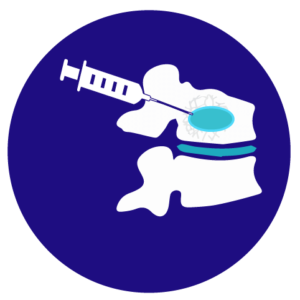
BALLOON kyphoplasty
Most people experience pain their back at some point in their life. Usually rest and pain relief medications ease the pain. When the pain is persistent, it can be an indicator of a more serious underlying condition.
When is a Balloon kyphoplasty or Spine Jack operation needed?
Balloon kyphoplasty/Spine Jack is a minimally invasive spinal orthopaedic procedure used to treat painful vertebral compression fractures (VCFs) in the spine. It involves injecting acrylic bone cement into the fractured vertebra, usually caused by Osteoporosis . Using a visually guided needle and a balloon or spine jack to inflate and recreate vertebral height, the cement is injected into the space to support the vertebra. Upon hardening, the cement provides strength and much needed support to the fractured vertebra, making the pain better.
I will discuss all benefits and risks of the procedure with you at your consultation. If you have any concerns about the procedure please ask me during your consultation.
I work with a team of three Consultant Surgeons, Consultant Radiologist and a very experienced Physiotherapy team and discuss all complex cases in our fortnightly multidisciplinary team meeting (MDT) to be able to provide a first class service.
How is a Balloon Kyphoplasty performed?
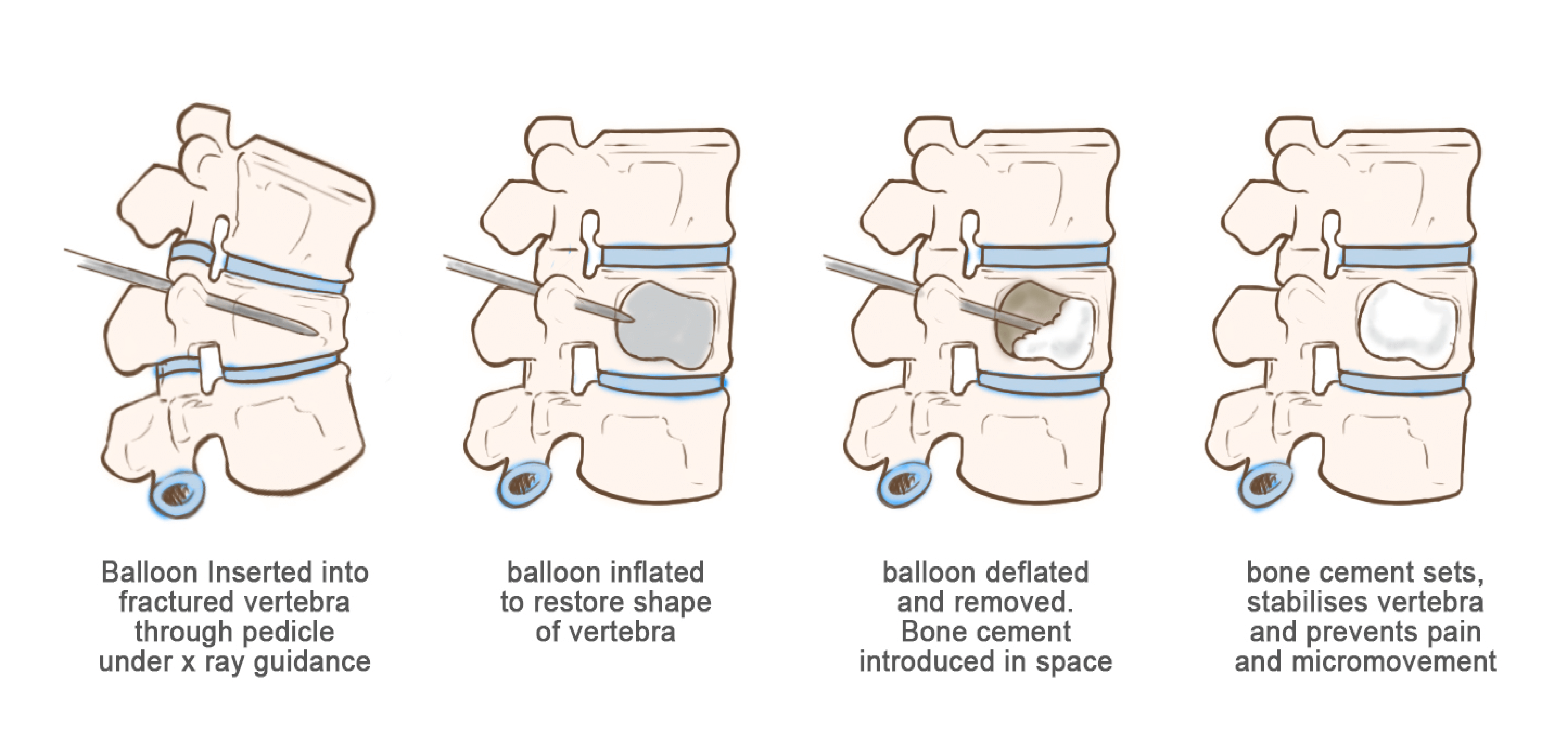


Getting Ready for surgery?
There are risks of an anaesthetic and surgery, such as developing pneumonia etc. Elderly people have higher rates of complications from surgery. So do people with excess weight or medical illnesses such as Type 2 diabetes, heart disease, if you smoke or if you have multiple medical problems.
You must inform my anaesthetist, the nurse looking after you, preassessment team and me of all the medications you are taking, any allergies that you may have including drug reactions as these can seriously impact your surgery and recovery. Drugs such as aspirin, clopidogrel, and other blood thinners may need to be reviewed or stopped under guidance before surgery. If you are diabetic, especially on insulin, this needs to be highlighted early.
Do try if time permits to stop smoking, lose weight and make some lifestyle changes as these will make your recovery smoother.
Balloon Kyphoplasty
This is a minimally invasive method of treating a vertebral compression fracture with cement stabilization to reduce pain caused by an osteoporotic vertebral fracture.
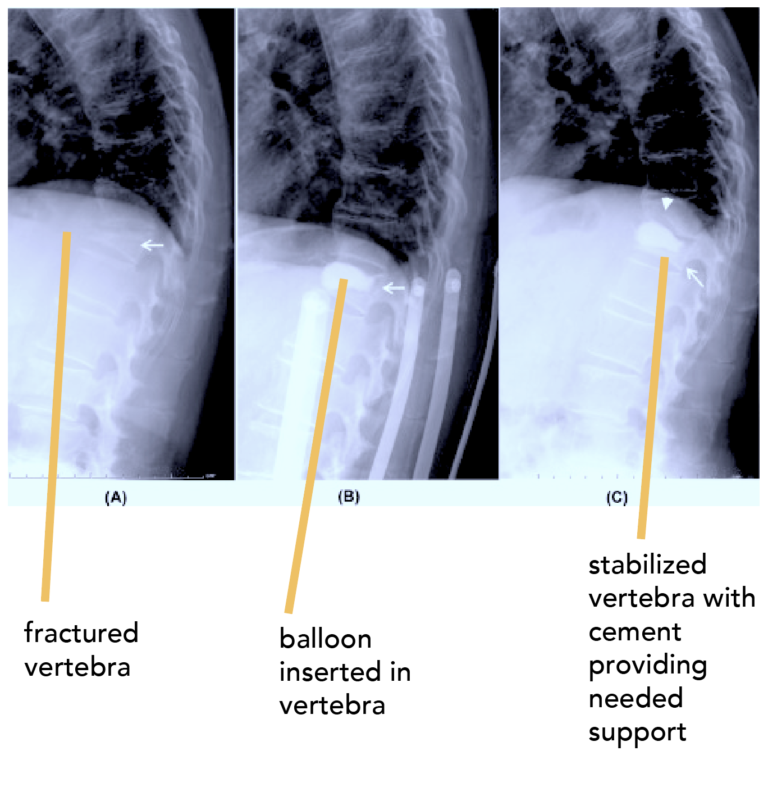


What are the risks of a Balloon Kyphoplasty operation?
The complication rate for Balloon kyphoplasty is uncommon at less than 2% (2 in a 100). There are, however, some risks associated with the procedure which I will discuss with you along with my own success rates:
- Infection: The risk of infection is less than 1%. All my patients receive a dose of intravenous antibiotics when they are going off to sleep. If you develop an infection, it is most likely to be a superficial wound infection that will resolve with a short course of oral antibiotics and is not usually a cause for serious concern.
- Bleeding: Blood loss is usually minimal with a balloon kyphoplasty.
- DVT: Developing blood clots in the legs (deep vein thrombosis – DVT) is a risk of any surgery. The risk is minimised by using thrombo-embolic deterrent stockings (TEDS) and mechanical pumps. These pumps squeeze your lower legs, helping the blood to circulate. They are put on when you go to sleep and stay on until you start to mobilise. I encourage early mobilisation as this also helps to prevent DVT.
- Nerve Injury: The opening made into the fractured bone is close to the emerging spinal nerves so there is a small risk of physical damage to the nerve. This can lead to a loss of nerve function with persisting pain, weakness and numbness in the territory of that nerve. I keep this risk to a minimum by the use of x-ray guidance while performing the procedure.
- Cement Leakage: When injecting bone cement there is a chance some of it may leak out of the vertebral body. If this happens, it can cause compression of the nerves, resulting in leg pain. This may require further surgery to remove the piece of cement. The use of the balloon technique keeps the risk of cement leakage to a minimum.
- Other Back Pain: Balloon kyphoplasty is intended to treat your acute fracture pain. It will not relieve you of any other back pain that you may have.
- Adjacent level fracture: Having had a vertebral compression fracture, you are at risk of having further fractures at adjacent levels which may cause further pain and need additional treatment.
How long should I expect to stay in hospital?
What can I expect after my procedure?
What should I expect at home?
- The treating physiotherapist usually provides exercises that you can follow easily at home. The ward team will prescribe pain-relief medicines. Non-steroidal anti-inflammatory drugs (NSAIDs) are not always prescribed as they can cause oozing from the wound.
- Stool-softeners. These are sometimes required initially to in to avoid constipation which would prevent excessive straining during bowel movement.
- Look after your wound by avoiding activities like bathing, swimming, and hot-tubs until the incision has completely healed to prevent rupturing of sutures and infection from setting in. The absorbable sutures used for surgery usually dissolve in a few days after surgery. A water proof dressing is used to cover the wound to allow showering. Do ring the ward if you have any concerns.
- You should continue with the physiotherapy program and follow the prescribed exercises. You should avoid activities like running or lifting heavy weights (typically over 5 pounds).
- You are advised to use compression stockings to prevent blood clot formation, until you are completely mobile.
- I would like you to download and use the link to the app for MyRecovery to collect information which helps me improve my service (https://www.myrecovery.app/rba).
Specially Customised for you
Your version of the app will be customised specifically for you, by your surgeon.
This app will provide you with video messages from your consultant, highlighting key points during your patient journey.
To aid in your recovery process, it will provide you with:
- Interactive exercise plans
- Demonstration videos
- Progress graphs
- Useful articles chosen by your clinical team and more.
This app is in conjunction with Total Orthopaedics. To download the app, please scan in the QR code below:
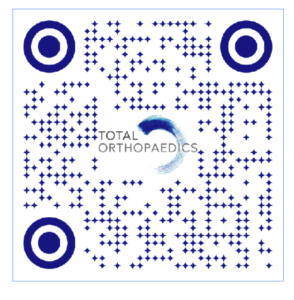


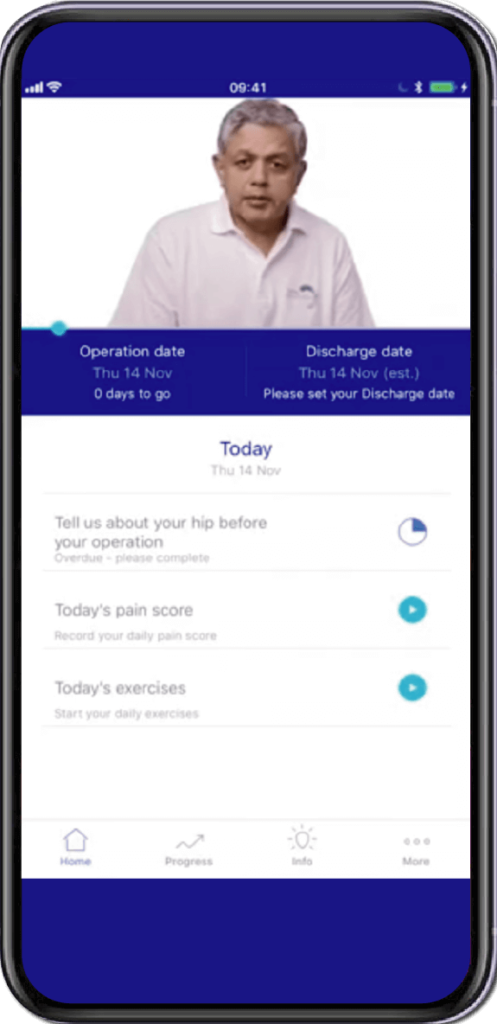


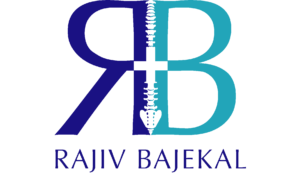


Rajiv Bajekal is a Consultant Orthopaedic Surgeon with special interest in Spinal and Back-related issues. He has developed a pragmatic approach to managing back pain and sciatica with non-surgical techniques, injections and minimally invasive techniques. Mr Bajekal is also a Board-Certified Lifestyle Medicine Practitioner and believes in providing lifestyle medicine advice to his patients for better long term health gains and better spinal health. He has been consulting since 1998. He consults both privately and on the National Health Service (NHS) and is passionate about making sure patients are in control of their healthcare.
Mr Bajekal is a member of the following institutions:
- British Medical Association (BMA)
- British Association of Spine Surgeons
- British Society of Lifestyle Medicine (BSLM)
- Plant-Based Health Professionals
- Patient Information
- Hospital Practices
- Spire Bushey Hospital
- BMI The Cavell
- BMI The King’s Oak
- Contact
- Blog
- Resources
- Glossary
Additional Links
Mr Bajekal works in conjunction with Total Orthopaedics UK. For more details please click here.
For more detailed information on plant-based nutirition please visit: www.rohinibajekal.com
For more detailed information on women’s health please visit: www.nitubajekal.com
